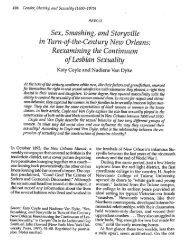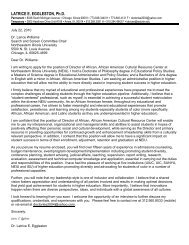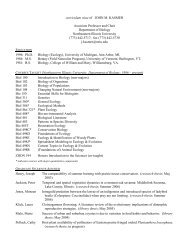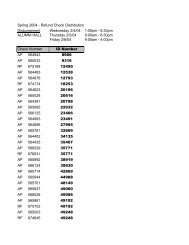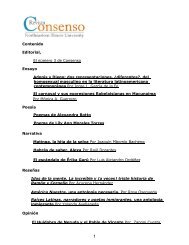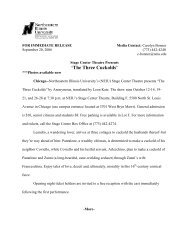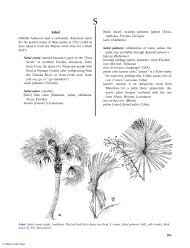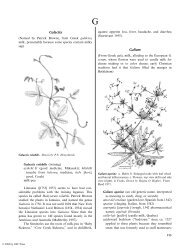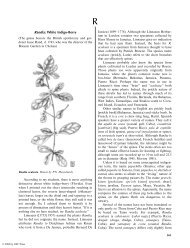Herba Cana - Northeastern Illinois University
Herba Cana - Northeastern Illinois University
Herba Cana - Northeastern Illinois University
You also want an ePaper? Increase the reach of your titles
YUMPU automatically turns print PDFs into web optimized ePapers that Google loves.
© 2004 by CRC Press<br />
The Ethnobotany 509<br />
Picramnia pentandra. (Left). a. Branch with pistillate inflorescences. b. Staminate flower, side view. c. Staminate flower,<br />
longitudinally dissected. d. Floral diagram of staminate flower. e. Pistillate flower, side view. f. Pistillate flower, longitudinally<br />
dissected. g. Floral diagrams of pistillate flower. (Right). a. Branch with fruit. b. Serial buds in leaf axil. c. Leaf with opposite<br />
leaflets. d. Leaf with alternate leaflets. e. Fruits, complete and transversely dissected, showing variation in seed numbers. Drawn<br />
by Priscilla Fawcett. Correll and Correll 1982.<br />
quina [quinina] de la tierra [del país] (wild quinine,<br />
Cuba)<br />
snake-root [snake-stick, snake-wood] (Bahamas)<br />
vaillant garçon (strong waiter, Haiti)<br />
Olaf Swartz gave us both the genus and species<br />
names for these trees in the late 1700s. He founded the<br />
genus on plants from Jamaica, and P. pentandra he<br />
discovered on Montserrat in the Lesser Antilles. Today<br />
the genus contains 45 species, all confined to tropical<br />
America (Mabberley 1997).<br />
As suggested by the references to ague and quinine<br />
in the common names, this is a venerable remedy for<br />
fevers, malarial and otherwise (Roig 1945, Liogier<br />
1974, Ayensu 1981, Morton 1981, Beauvoir et al.<br />
2001). Throughout the Caribbean, the tree is used as a<br />
tonic and febrifuge (leaves, roots, bark), and against<br />
diarrhea. Roots are boiled with Chiococca alba and<br />
the decoction used to alleviate gas and menstrual<br />
cramps. That tea is used against colds and tuberculosis,<br />
and to increase the appetite (Roig 1945, Ayensu<br />
1981). In Hispaniola, the wood is rarely used, but a<br />
red dye is extracted from the flowers (Liogier 1974).<br />
Haitians consider a decoction made from leaves and<br />
bark effective against fever, indigestion, dysentery,<br />
intestinal worms, and anorexia (Beauvoir et al.<br />
2001). Caribs on Dominica soak the wood chips to<br />
make a bitter drink to alleviate appetite loss. Sap from<br />
the bark is put on lesions from yaws (framboesia)<br />
(Hodge and Taylor 1957). Among the Warao of<br />
Guyana, it is used to ‘‘bitter the blood’’ (Reinders<br />
1993).<br />
Pilea<br />
(John Lindley named this with Latin pileus, cap or hat;<br />
he thought the sepals of pistillate flowers covering the<br />
achene resembled the ‘‘felt caps’’ used by Romans)<br />
Pilea microphylla (small-leaved)<br />
alfombra (carpet, Venezuela)<br />
artillery plant (from the way it ‘‘shoots’’ its seeds<br />
into nearby areas, Florida, Jamaica, Puerto<br />
Rico, Virgin Islands); escopetilla (little shotgun,<br />
Venezuela); gunpowder plant (was it really used<br />
in manufacturing powder? or is this another<br />
allusion to ‘‘shooting’’ its seeds?, England);<br />
kanonneer-plant (Dutch Antilles)<br />
baby puzzle (Jamaica, Lesser Antilles); baby’s lace<br />
[lace plant] (Bahamas, Jamaica, Lesser Antilles,<br />
Belize)<br />
beldroega (derived from Arabic burd(u)lagá,<br />
usually applied now to Portulaca, Brazil)<br />
botisuelo (ground cover, Hispaniola)<br />
brilhantina (shiny one, Brazil)<br />
dentelle [petite dentelles, tidentelles] (little tooth<br />
[teeth], Hispaniola)





